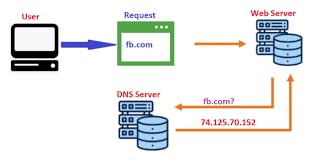Welcome back, tech enthusiasts! In this journey through the digital realm, we're about to unveil the magic behind the curtains – the inner workings of the Internet. So grab your virtual hard hats and join us as we embark on a fascinating voyage into the world of cyberspace.
🤔So, what's this Internet thing, anyway? Some say it's a mystical cloud hanging in the sky, a digital enigma that defies understanding. But hold on to your virtual hats, folks, because it's time to demystify the magic.
At its core, the Internet is as simple as a super-long piece of wire. Imagine it as a massive network of interconnected computers, all chatting with each other through this colossal web of wires. These computers could be as close as your neighbour's house or as far away as the North Pole. They're all part of the grand Internet party.

Now, let's meet our star players: servers and clients. Servers are the unsung heroes, working 24/7 to serve you data and files whenever you want to access a website. Think of them as friendly librarians who never sleep. Clients, on the other hand, are the folks like you and me who use our computers to browse the web. We're here for the books, er, data, and files that servers kindly provide.

❓But wait, how on Earth do we find what we need in this colossal digital library? The answer lies in the behind-the-scenes magic. When you type "Google.com" into your browser, your computer sends a message to your trusty Internet service provider (ISP). ISPs are like the gatekeepers to the Internet; they make it all possible. Your ISP then passes your message to a DNS (Domain Name System) server, which is like a super-smart phone book.
This DNS server does some detective work and finds the exact IP address (think of it as a secret code) of the website you want to visit. Every computer on the Internet has a unique IP address, just like a home address. Once the DNS server unveils this secret code, it sends it back to your browser via your ISP.
Now, armed with this secret code (the IP address), your browser can directly request data from the website's servers. These servers, located somewhere out there in the digital universe, send you all the data and files you need to see the website. Voila! You're now surfing the web like a pro.
So, there you have it, a simplified explanation of how the Internet functions. But what about those undersea cables that connect continents, you ask? 🤔
It's one of the Internet's most remarkable aspects. Massive undersea cables crisscross the ocean floor, connecting every corner of the world. These high-tech marvels consist of hundreds of fiber optic strands that transmit data using lasers at astonishing speeds – up to 400 gigabytes per second! These cables are the unsung heroes of the digital age, enabling us to explore the web's vast wonders with just an IP address and some magic signals that traverse the globe at the speed of light. To put that into perspective, at the Earth's surface, the speed of light means it could complete approximately 7.5 orbits around the Earth in just one second! 🌍💨
➡️ So, the next time you're binge-watching cat videos or shopping online, remember the incredible journey happening behind the scenes – a web of wires and signals making the Internet dance to your tune.
